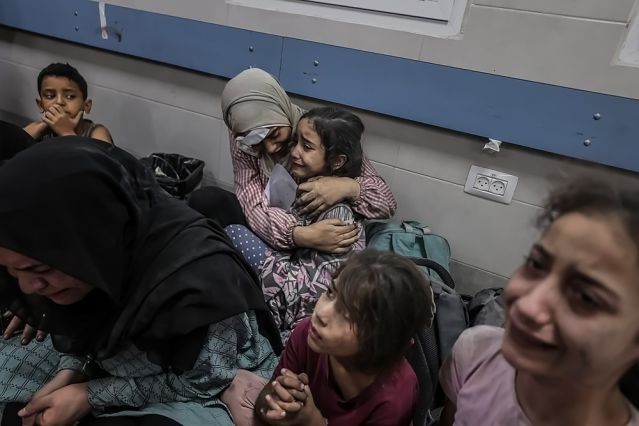Trauma
War, Toxic Stress, and the Mental Health of Children
Children in war zones face extreme levels of stress. The effects can be severe.
Posted November 23, 2023 Reviewed by Devon Frye
Key points
- The stress response evolved to help us cope with short-term threats, not persistent, severe danger.
- When stress is persistent and severe, it can become toxic, causing short and long-term harm to body and mind.
- Toxic stress is endemic among children in war zones, who face continual threats to their survival.
- Children are resilient, but resilience has its limits. To prevent lasting harm, the violence in Gaza must end.

How are children affected by the violence, loss, and chaos of war?
A helpful way to understand the impact of war on children is through the lens of something called toxic stress. Toxic stress refers to intense, prolonged stress stemming from continuous threats to a child’s physical or psychological safety. In extreme situations, the threat may be to their very survival.
What is Toxic Stress, and Why Is It So Harmful?
To understand toxic stress, it’s helpful to first understand the basics of the human stress response.
In situations of real or perceived danger, a small, almond-shaped structure deep in the brain called the amygdala triggers a warning to the hypothalamus, which rapidly shifts the body into a state of alarm. Almost immediately, the stress hormones cortisol and adrenaline are sent coursing through the body, preparing us to fight, flee, or freeze (a reaction under the control of our sympathetic nervous system).
Our heart rate increases, our breathing becomes more rapid and shallow, our muscles tense up, our vision narrows to focus on the threat, and blood is sent to our arms and legs to prepare us for action. Less urgent biological processes such as digestion and immune functioning are dialed down. After all, if we’re about to be eaten by a lion, or hit by a car, digesting that tuna sandwich or fighting off a cold becomes pretty irrelevant.
Once the threat is gone—once we’ve escaped from it or eliminated it—our stress response system is deactivated. Our bodies return to their parasympathetic or normal (and hopefully relaxed) state, sometimes referred to as the “rest and digest” state.
The stress response system is essential for human survival. Thanks to this highly evolved system of threat management, we are remarkably well-adapted to recover from intense, short-term threats to our physical and psychological well-being. In fact, many seemingly traumatic events don’t result in long-term post-trauma reactions if they are brief and we have good social support available to help us cope in the aftermath.
What Happens When Stress Persists
The problem with stress arises when threats to our well-being, and especially to our survival, are continuous rather than brief.
In such situations, the body remains in a state of persistent alarm. There is no deactivation of the stress response, no turning off the stress hormones flooding our body. Gradually, this can take a powerful toll on our physical and psychological health. Our immune functioning drops, and we become vulnerable to a host of illnesses. Psychologically, we may become exhausted, anxious, depressed, angry, and show signs of trauma.
When threats are persistent and intense, we refer to the stress they generate as toxic stress.
Children are especially vulnerable to the effects of toxic stress because, unlike adults, they have fewer resources of their own to manage threats to their well-being. The most widely studied sources of toxic stress among children are child abuse and neglect. Abuse and neglect are especially harmful because they are typically threats from the very people on whom children depend for their safety—their parents or other caregivers. Trapped in situations of continuous threat, with no safe place, no reliable source of comfort and reassurance, abused and neglected children may remain in a state of continuous alarm, with stress hormones flooding their young bodies.
For infants and very young children, whose brains are undergoing the greatest period of development in the human lifespan, toxic stress can have lasting harmful effects that are readily visible on brain scans and are linked to a host of short- and long-term problems such as low self-esteem, difficulties trusting people, anxiety, depression, problems with emotion regulation, sleep problems, eating disorders, self-harming behavior, and impaired concentration. We have all sorts of clinical diagnoses for these reactions, but really, what we’re seeing are the diverse effects of toxic stress.
War as an Experience of Toxic Stress
In many studies of the effects of war on children, the primary focus has been on post-traumatic stress disorder (PTSD). Indeed, rates of PTSD among children in war zones are, not surprisingly, much higher than in children living in peaceful settings.
However, PTSD is just one manifestation of war-related toxic stress. It fails to capture the broad array of harmful consequences of exposure to the persistently severe stress of armed conflict. PTSD focuses our attention on reactions to specific, terrifying events such as explosions, witnessing the killing or wounding of loved ones, and the destruction of one’s home. These are common and terrifying events in wartime, and PTSD can be a useful and relevant diagnosis.
But what it fails to capture is the impact on children’s bodies and minds of living in an environment filled with multiple, continuous threats, many of which lack the drama of bullets and bombs: extreme poverty; chronic hunger, malnutrition and dehydration; a lack of shelter from harsh weather; separation from extended family and close friends, and from beloved pets; and frightened, stressed-out parents whose capacity for warmth and reassurance may be greatly diminished, and who cannot provide the safety their children desperately need (see my post: "Want to Help Refugee Children? Support Their Parents"). These sorts of stressors impact children in ways that go beyond the narrow diagnostic criteria of PTSD, coloring every aspect of their psychological, social, and spiritual experience.
This is the current situation of children in Gaza, as it is for children in other war zones around the world. No doubt, when the violence in Gaza abates and families can begin the process of rebuilding their lives, there will be studies documenting the prevalence of PTSD among Palestinian children who survived the prolonged bombing and destruction of their homes and communities, the loss of loved ones and friends. But those studies will not fully capture the harm to children’s mental health and psychosocial well-being caused by the persistent threats—the toxic stress—they are experiencing in this ongoing and brutal war.
To remediate the effects of the toxic stress to which children in Gaza are being continuously exposed, the violence needs to end and safety must be re-established. Access to food, water, shelter, and healthcare must be restored immediately. Children need to return to the predictable structure and routines of school, and parents will need support to address their own stress, trauma, and grief.
Numerous studies have documented the resilience of Palestinian children to chronic adversity, and their current experience of extreme stress in no way condemns them to lives of distress or impairment. Our bodies and minds evolved to heal, and harm can be repaired after even the most terrible experiences. But it is also true that resilience has its limits, and each day this war continues, the more enduring will be its legacy on the bodies and minds of its youngest victims.




